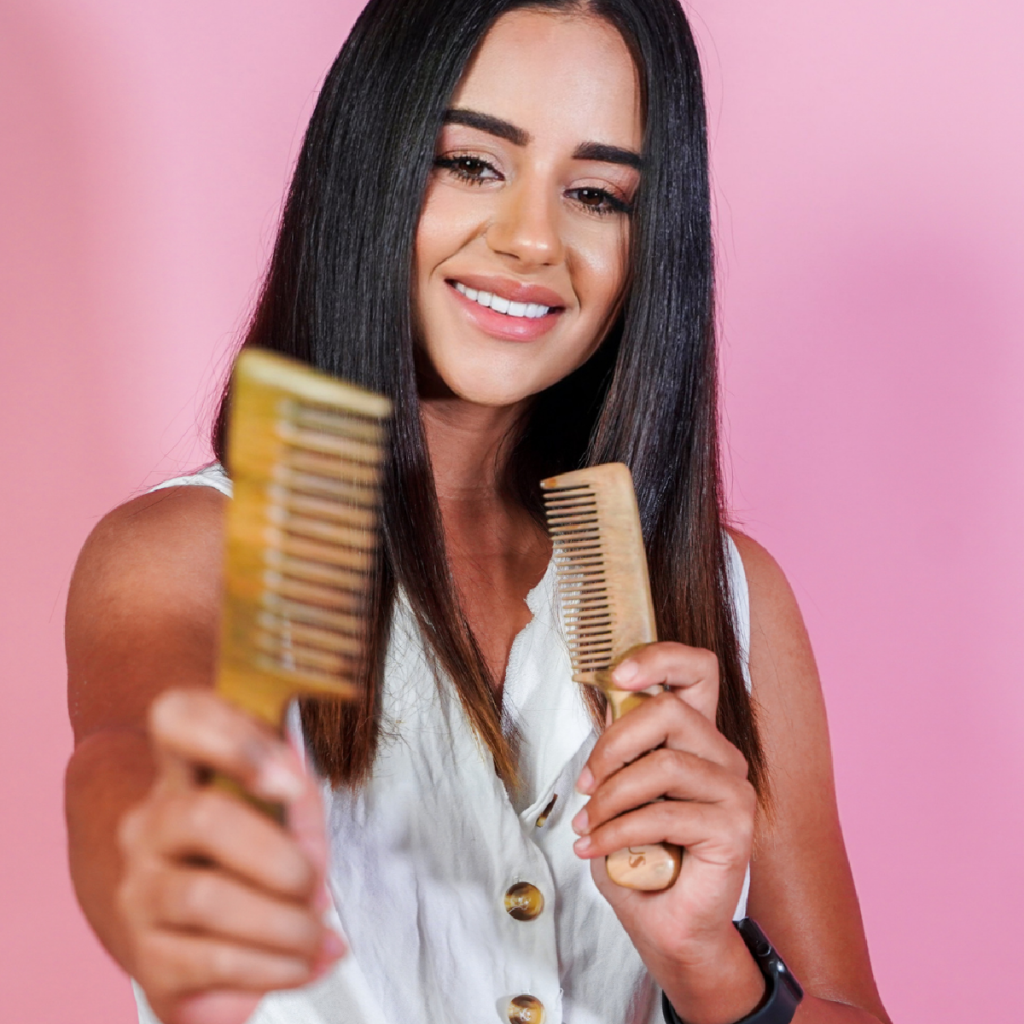Discover how brushes and combs can effectively combat static and frizz in your hair.
Can Brushes and Combs Help Reduce Static and Frizz?
If you’ve ever experienced a “bad hair day” due to static and frizz, you know how frustrating it can be. But fear not! There’s a simple solution that you might already have in your bathroom: brushes and combs. Yes, these everyday hair tools can actually help tame static and frizz, giving you the beautiful and manageable hair you desire.

Understanding Hair Static and Frizz
Before we delve into how brushes and combs can help, it’s important to understand what causes hair static and frizz. Hair static occurs when there is an imbalance of electrons in your hair, resulting in those pesky flyaways and sticking strands. On the other hand, frizzy hair is caused by a lack of moisture and natural oils, leading to hair that appears dry and unruly.
What Causes Hair Static?
There are several factors that contribute to hair static. One common culprit is dry air, especially during the winter months when indoor heating removes moisture from the environment. The lack of humidity in the air makes it easier for electrons to build up on the hair strands, creating static electricity. Synthetic materials, such as polyester and nylon, can also create friction against your hair, causing static buildup. These materials have a tendency to rub against the hair, transferring electrons and creating an electric charge that leads to static. Additionally, brushing your hair vigorously or over-washing can strip away the natural oils that help keep static at bay. When the hair is devoid of its natural oils, it becomes more susceptible to static electricity.
Moreover, the type of hair you have can also play a role in hair static. Fine hair, for example, is more prone to static due to its structure. The thinner strands of fine hair allow for a greater surface area, increasing the chances of static electricity buildup. Additionally, certain hair treatments, such as chemical straightening or coloring, can make the hair more susceptible to static, as these processes can disrupt the hair’s natural moisture balance.
The Science Behind Frizzy Hair
Frizzy hair is often a result of hair cuticles that are raised and rough, instead of lying flat. The cuticle is the outermost layer of the hair shaft, and its purpose is to protect the inner layers of the hair. When the cuticles are not smooth, they become porous, allowing moisture to pass through and escape easily. As a result, your hair absorbs excess moisture from the air, leading to frizz. The raised and rough cuticles also create a rough surface, causing the hair strands to interlock and tangle, further contributing to the appearance of frizz.
Did you know that humidity plays a significant role in aggravating frizz? When the air is humid, it contains a higher level of moisture. This excess moisture is absorbed by the hair, causing the cuticles to swell and the hair strands to expand. As a result, the hair becomes more susceptible to frizz, as the increased volume and moisture make it difficult for the cuticles to lie flat. So those humid summer days can wreak havoc on your hair, leaving you with a frizzy mane.
Furthermore, certain hair care practices can exacerbate frizz. Using hot styling tools, such as flat irons or curling wands, can cause the hair to lose its natural moisture, making it more prone to frizz. Additionally, harsh hair products that contain sulfates or alcohol can strip away the hair’s natural oils, leaving it dry and susceptible to frizz. It’s important to choose hair care products that are specifically formulated to combat frizz and provide moisture to the hair.
In conclusion, understanding the causes of hair static and frizz is crucial in finding effective solutions to combat these hair woes. By addressing the underlying factors, such as dry air, synthetic materials, and lack of moisture, you can take steps to minimize static electricity and keep your hair frizz-free. So, let’s explore how brushes and combs can help in the next section!
The Role of Brushes and Combs in Hair Care
Now that we have a better understanding of the culprits behind hair static and frizz, let’s explore how brushes and combs can come to the rescue.
When it comes to maintaining healthy and beautiful hair, using the right tools is key. Brushes and combs not only help detangle knots but also play a significant role in distributing natural oils, reducing breakage, and minimizing static buildup.
Different Types of Brushes and Their Uses
There are various types of brushes available, each designed to cater to different hair types and needs. For those with fine and delicate hair, a brush with soft bristles or a paddle brush works best. These brushes are gentle on the hair and help distribute the natural oils from your scalp to the rest of your hair, ensuring it stays moisturized and tangle-free.
On the other hand, individuals with thick and coarse hair require brushes that can handle the extra volume and texture. For this hair type, a wide-toothed comb or a vented brush can work wonders. The wide teeth of these combs help detangle knots without causing breakage, making them ideal for those with unruly hair.
Furthermore, vented brushes are designed with openings or vents in the back, allowing air to circulate through the brush. This feature helps to speed up the drying process, making it a great tool for those who prefer blow-drying their hair.
How Combs Contribute to Hair Health
Combs, although seemingly simple, play an important role in maintaining hair health. The wide-spaced teeth of a comb help detangle hair gently, reducing the risk of breakage. This is especially beneficial for individuals with curly or textured hair, as it helps prevent damage and preserve natural curl patterns.
Additionally, the material of the comb can make a difference in hair health. Combs made of materials like wood or bone have anti-static properties, minimizing friction and further reducing static buildup. These natural materials are also gentle on the scalp, reducing irritation and promoting healthy hair growth.
Using a comb made of wood or bone can also help distribute natural oils throughout your hair. When you run the comb through your hair, it helps to evenly spread the oils from your scalp to the ends of your hair strands. This not only keeps your hair hydrated but also adds a natural shine.
When choosing a comb, it’s important to consider the spacing between the teeth. Wide-toothed combs are suitable for detangling wet hair, while finer-toothed combs are better for styling and creating precise parts.
In conclusion, brushes and combs are essential tools in hair care. They not only help detangle knots but also contribute to overall hair health by distributing natural oils, reducing breakage, and minimizing static buildup. By choosing the right brush or comb for your hair type and needs, you can achieve healthier, more manageable hair.
Can Brushes and Combs Reduce Static and Frizz?
Now, let’s explore the impact that brushes and combs have on static and frizz control.
The Effect of Brushing on Hair Static
Brushing your hair helps in two ways when it comes to combating static. Firstly, it helps distribute the natural oils produced by your scalp throughout your hair, moisturizing it and minimizing the dryness that leads to static. This distribution of oils also helps to weigh down the hair strands, reducing flyaways and static cling. Additionally, brushing helps neutralize the positive charges that cause static, as the bristles of the brush attract the excess electrons and remove them from your hair. This action not only reduces static but also leaves your hair looking smoother and more polished.
One trick you can try is spritzing a little hairspray on your brush before running it through your hair to further reduce static buildup. The hairspray acts as a temporary fixative, creating a barrier between your hair and the surrounding environment, preventing static from forming. It’s important to note that while this technique can be effective, it’s best to use hairspray sparingly to avoid weighing down your hair or causing product buildup.
Combing and Its Impact on Frizz Control
Combing your hair is equally important when it comes to frizz control. As mentioned earlier, frizzy hair is often the result of raised and rough cuticles. Using a wide-toothed comb or a brush with widely spaced bristles helps smooth out these cuticles by distributing the natural oils from your scalp down the length of your hair. This, in turn, reduces the porosity of your hair, preventing it from absorbing excess moisture from the air and minimizing frizz.
When combing, it’s crucial to be gentle and avoid aggressive brushing, as it can create friction and lead to more frizz. Start by detangling your hair from the ends, working your way up to the roots. This approach helps prevent breakage and minimizes the stress on your hair strands. Additionally, consider using a comb or brush made from materials like wood or natural bristles, as they are generally gentler on the hair and less likely to cause static or frizz.
Incorporating a leave-in conditioner or a frizz-control serum into your hair care routine can also enhance the effects of combing. These products provide additional moisture and help to seal the cuticles, further reducing frizz and promoting smoother, more manageable hair.
Choosing the Right Brush or Comb for Your Hair Type
When it comes to brushes and combs, one size does not fit all. It’s essential to choose the right tool for your specific hair type.
Brushes for Fine Hair
If you have fine hair, opt for a brush with soft bristles or a paddle brush. These brushes are gentle and won’t weigh down your delicate strands. You can also consider using a round brush to add volume to your hair while blow-drying.
Combs for Thick Hair
For thick hair, a wide-toothed comb or a vented brush is your best bet. These tools will help detangle your hair without causing breakage and provide airflow to your scalp, promoting healthy hair growth.
Additional Tips to Reduce Static and Frizz
While brushes and combs are crucial in combating static and frizz, there are additional steps you can take to keep your hair under control.

Hair Care Products for Static and Frizz Control
To enhance the effectiveness of your brushes and combs, consider using hair care products specifically formulated to reduce static and frizz. Look for products that contain ingredients like argan oil or silicone, as these help to seal the cuticles and provide a protective barrier against moisture loss.
Lifestyle Changes to Minimize Hair Static and Frizz
In addition to using the right tools and products, making small lifestyle changes can go a long way in minimizing hair static and frizz. For starters, avoid over-washing your hair, as this can strip away the natural oils that help keep static at bay. Instead, try washing every other day or use a dry shampoo in between washes. Additionally, investing in a humidifier for your home can help combat dry air and reduce static buildup. Lastly, avoid using heat-styling tools excessively, as they can further deplete your hair’s moisture levels and worsen frizz.
So there you have it! Brushes and combs aren’t just for detangling and styling, but they also play a vital role in reducing hair static and frizz. By understanding the causes of these hair woes and choosing the right tools, you’ll be well on your way to achieving smooth, static-free locks. Give it a try and say goodbye to those pesky bad hair days!





